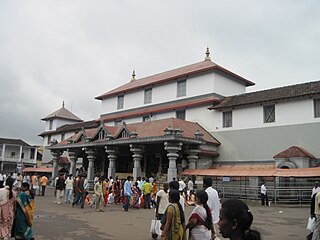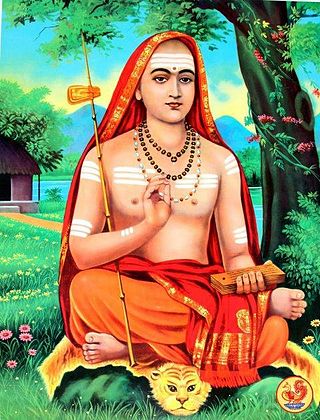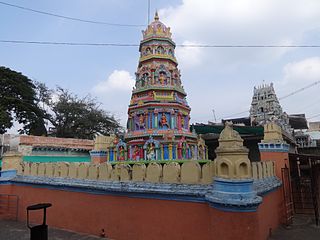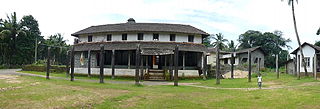Havyaka Brahmins are a Hindu Brahmin community native to coastal Karnataka and the Kasaragod district of Kerala. Havyakas are known by their unique culture and language. They fall under the Pancha-Dravida Brahmin category and are Smartas in religion and follow the Advaita philosophy propounded by Adi Shankaracharya.

Dharmasthala is an Indian temple town on the banks of the Nethravathi River in the Belthangady taluk of the Dakshina Kannada district in Karnataka, India.

A kuladevata, also known as a kuladaivaṃ, is an ancestral tutelary deity in Hinduism and Jainism.

Kukke Subramanya is a Hindu temple located in the village Subramanya, of Kadaba taluk in Dakshina Kannada district, Karnataka, India. In this temple Kartikeya is worshipped as Subramanya, lord of all serpents. The epics relate that the divine serpent Vasuki and other serpents found refuge under Subramanya when threatened by the Garuda. The priests in the temple are Shivalli Madhva Brahmins. The poojas and other daily rituals in the temple are performed as per Madhvacharya's Tantra Sara Sangraha.

Subramanya is a village located in Kadaba Taluk in Dakshina Kannada, India. The Kukke Subrahmanya Temple is located here. It is about 105 kilometres (65 mi) from Mangalore, connected by train and road. It was originally named "Kukke Pattana".

Sri Sharadamba Temple is a famous Hindu temple dedicated to goddess Saraswati in the holy town of Sringeri in Karnataka, India.

Sri Sri Raghaveshwara Bharathi (originally, Harish Sharma), is an Indian religious guru and the present mathadhis (Guru) of Shri Ramachandrapura Mutt, Hosanagara in Shimoga district in the Indian state of Karnataka. He is the 36th mathadhis of Shri Ramachandrapura Math. He took sannyasa from Jagadguru Sri Ragavendra Bharati Mahaswamiji the previous mathadhis, in April 1994. He is a follower of Advaita Vedanta.
Temples of the Indian State of Karnataka illustrate the variety of architecture prevalent in various periods. The architectural designs have found a distinguished place in forming a true atmosphere of devotion for spiritual attainment.
Vidyaranyapura Agrahara is a small village near Sringeri in the state of Karnataka, India. It houses several brahmin families associated with the Sringeri Sharada Peetham and local temples.

Sthānika Brāhmins belong to Hindu Tuluva Smartha Brahmin group.
Karopady is a small village in Dakshina Kannada district, Karnataka, in far southern India. It is the border village between Karnataka and Kerala. Kasaragod District is the neighbouring district in Kerala State.

Uppinangady or Ubar is a town in the Dakshina Kannada district in the state of Karnataka. It is surrounded by the Kumaradhara River on one side and Nethravathi River on the other. When the town's two surrounding rivers rise during the rainy season and meet, this is called the "Sangam" which is a Sanskrit word for confluence. The Sangam is a major event as people from the surrounding villages crowd the river banks to witness the merge. The population of Uppinangady is 7,172.

Shri Gaudapadacharya Math, also known as Kavaḷē maṭha, located in Kavale, Ponda, Goa, is the oldest matha of the Smarthan Saraswat Brahman Samaj. It was founded by Gauḍapāda around 740 AD, whose student was Govinda Bhagavatpada, the guru of Adi Shankara, a highly influential figure in Hinduism. There is also a belief that Gauḍapāda himself established the Shri Gaudapadacharya matha when he lived in Gomantak (Goa). Thus, the matha came to be known as Shri Saunstan Gaudapadacharya matha. Unlike other mathas, Shri Gaudapadacharya matha is not a polemical center established to influence the faith of all Hindus, its jurisdiction is limited to only Dakshinatya Saraswat Brahmins. The Peetadhipathi "head monk" is Śrī Gauḍapadācārya. Smartist Goud Saraswat Brahman Samaj and Rajapur Saraswat Brahmin are its main disciples.

Balakudru Shrimatha is the Gurupeetha for the brahmins of South Canara District mainly Shivalli sects who follow Advaitha philosophy. This Peetha is now running upon the directions of Jagadguru of Shringeri Shaaradha Peetha. The ashram is headed now by Shri Shri Narasimhashrama Swamiji.

Veerbhadra Temple, is situated in the holy Shri Kshetra Yadur, on the banks of holy river Krishna in Chikodi Taluka of Belagavi District, Karnataka, India, approximately 94 kilometres (58 mi) from Belgaum. It lies on the banks of the majestic Krishna River.

The Karaneeswarar Temple is a 12th-century Hindu temple in the neighbourhood of Mylapore in Chennai, India. The temple is dedicated to Shiva. The main deity is a shivalinga. There are also shrines to Sarvamangala Vinayaka, Dandapani, Durga, Lakshmi and Saraswathi.

The Panchagrama Brahmins are a Brahmin community that follow the Smartha Sampradaya. They belong to the Indian state of Karnataka, and reside primarily in the districts of Udupi, Shimoga and Chikmaglur, Bengaluru and other cities.

Ramachandrapura Math (monastery) is a Hindu monastery located in Hosanagara taluk of Shimoga, Karnataka. The Matha is followed mainly by the Havyaka Brahmins in Uttara Kannada, Dakshina Kannada, Udupi, Shimoga districts of Karnataka and Kasaragod district of Kerala. It was established by Adi Shankaracharya originally near Gokarna, a holy town on the west coast of India. The matha was initially known as Raghuthama Matha. The Swami of the matha is a celibate (brahmacharya) and a Havyaka by birth. He adds the title Bharati to his name. The present guru is Jagadguru Shankaracharya Shri Raghaveshwara Bharathi MahaSwamiji. He was initiated sanyasa by his guru Jagadguru Shankaracharya shri Ragavendra Bharati mahaswamiji the 35th Pontiff of Shri Ramachandrapura Mutt.

Puttur Shree Mahalingeshwara Temple is a 12th-century temple, located in Puttur, Dakshina Kannada in the Indian state of Karnataka. Lord Shiva is the main deity.













